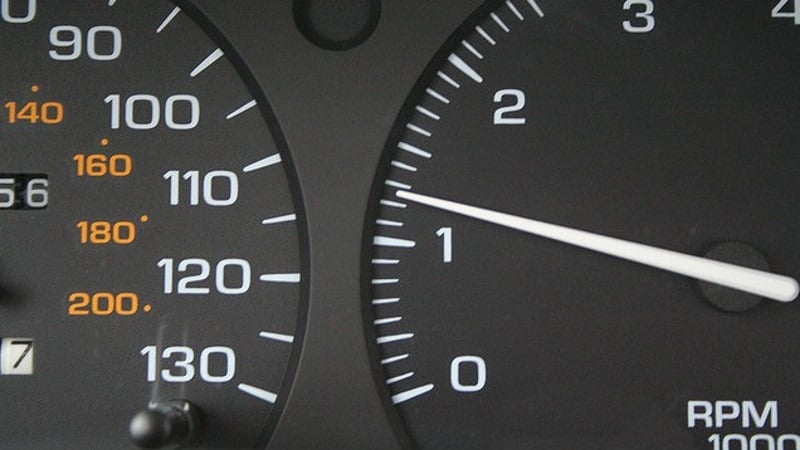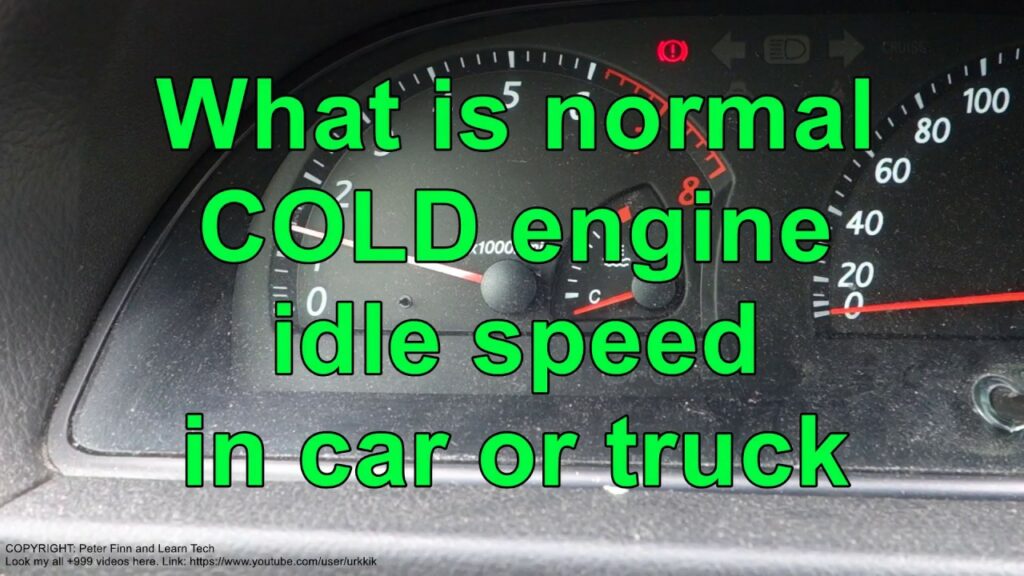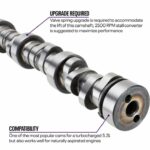When it comes to your car’s idle speed, there is no definitive answer. It depends on various factors such as the make and model of your vehicle, whether or not the air conditioning is on, and even the outside temperature. However, there are some general guidelines you can follow to ensure your car is running at an optimal idle speed.
If you’re like most drivers, you probably don’t give much thought to your car’s idle speed. But did you know that there is an ideal rpm range that your car should be idling at? Depending on the make and model of your car, that range can be anywhere from 600 to 1,000 rpm.
So why is it important to keep your car within this range? For one thing, it can help improve your fuel efficiency. If your car is idling too low, it’s going to consume more fuel than necessary.
And if it’s idling too high, well, that can put unnecessary wear and tear on your engine.
It’s also important to pay attention to your car’s idle speed if you notice any strange noises or vibrations coming from the engine bay. These could be signs that something is wrong and needs to be fixed.
So if you notice anything out of the ordinary, be sure to take your car into a trusted mechanic for a diagnosis.
In short, paying attention to your car’s idle speed is just good preventative maintenance. It can help keep your engine running smoothly and efficiently for many miles down the road.
What is the correct idle speed Rpm on Toyota
What Rpm is Too High for Idle?
The RPM, or rotations per minute, is a measure of how fast an engine is running. The higher the RPM, the more power the engine is producing. However, there is such a thing as too high of an idle RPM.
If an engine is idling too high, it can cause problems with the engine itself and also with the vehicle it’s in.
An idle that’s too high can cause an engine to overheat, which can lead to serious damage. It can also put unnecessary stress on other components like the alternator and battery.
In some cases, it can even cause transmission problems. And if you’re constantly driving with a high idle RPM, you’ll likely see decreased fuel economy as well.
So what’s considered too high of an idle RPM?
It really varies depending on the make and model of your vehicle. But in general, anything above 1,000 RPM is pushing it. Anything above 2,000 RPM is definitely too high and could start causing problems fairly quickly.
If you notice that your car’s idle RPMs are consistently higher than they should be, have it checked out by a mechanic as soon as possible.
Is It Normal for a Car to Idle at 1500 Rpm?
If your car idles at 1500 RPM, there could be a few different reasons why. It could be that your car is low on oil, or that the idle control valve needs to be replaced. If you notice that your car is idling high, it’s best to take it to a mechanic to have it checked out.
Why is My Rpm at 1 When Parked?
If you’re like most people, you probably don’t think much about your car’s RPMs. But if you notice that your RPM needle is stuck at 1 when your car is parked, it’s worth investigating. There are a few possible explanations for why this might be happening.
One possibility is that there is something wrong with the way your car’s engine is idling. If the idle speed is set too low, it can cause the RPMs to drop below 1 when the car is in park. This can be easily fixed by adjusting the idle speed setting on your car.
Another possibility is that there could be a problem with one of the sensors in your engine management system. If a sensor isn’t working properly, it can cause the engine to run erratically and the RPMs to fluctuate. This will usually require a trip to the mechanic to diagnose and fix the problem.
Finally, it’s also possible that your car’s battery may be dying or close to death. A weak battery can cause all sorts of electrical problems, including causing the RPMs to drop suddenly while driving or sitting in park. If you suspect this might be the case, it’s best to get your battery tested and replaced if necessary.
Is a Car Supposed to Idle at 1 Rpm?
No, a car is not supposed to idle at 1 RPM. In fact, it’s normal for a car to idle around 700-1000 RPMs. If your car is idling at 1 RPM, there could be something wrong with your engine.

Credit: grimmermotors.co.nz
Normal Idle Rpm When Ac is on
If your car has an automatic transmission, the ideal “normal” idle speed is around 700 RPM. When you turn on the air conditioning, the idle speed should increase to about 1,000 RPM. This is because the AC compressor puts a load on the engine, and the higher idle speed helps to offset that load.
If your car doesn’t have an AC compressor (or if it’s not engaged), then there shouldn’t be any difference in idle speed with or without the AC on.
What Should Rpm Be When Starting Car
If you’re like most people, you probably don’t give much thought to the RPMs (revolutions per minute) of your car’s engine when starting it up. But did you know that there is an optimal range of RPMs for starting a car? It’s generally accepted that the ideal range is between 500 and 800 RPM.
Why is this range considered ideal? Well, at lower RPMs the engine may not have enough power to get going, while at higher RPMs there’s a risk of damaging the engine. In the middle range, however, the engine should have just enough power to start without any issues.
Of course, every car is different and so you’ll need to consult your owner’s manual to see what the specific recommendations are for your vehicle. But in general, aim for an RPM somewhere in that 500-800 range next time you start your car and see if it makes a difference!
Is 1000 Rpm Idle Bad
If you’re like most car owners, you probably don’t give much thought to your vehicle’s idle speed. After all, as long as your car is running smoothly, what does it matter how fast the engine is turning? Well, it turns out that idle speed can actually be quite important.
An engine’s idle speed is the rate at which the crankshaft turns when the car is idling. This speed is measured in revolutions per minute (rpm). Most engines have an ideal rpm range that they should operate within, and if the engine is idling too low or too high, it can cause problems.
So what happens if your car’s idle speed is off? If the engine is idling too low (under 600 rpm), it can cause stalling and rough running. An excessively low idle can also indicate a problem with the fuel delivery system or spark plugs.
On the other hand, if the engine is idling too high (over 1000 rpm), it can put unnecessary strain on components like the alternator and battery. It can also make your car more difficult to drive at lower speeds.
Ideally, you want your car’s engine to be idling around 700-900 rpm when warm.
If you notice that your car’s idle speed has changed significantly, it’s best to have it checked out by a mechanic to make sure there isn’t a bigger issue at play.
Car Idling at 1000 Rpm
If you’re like most car owners, you probably don’t give much thought to your engine idling. But did you know that idling for just 10 seconds wastes more fuel than restarting your engine? And if your car is idling at 1000 rpm, that’s even worse!
Here’s why: when your engine is running at high speeds, it burns fuel much faster than at lower speeds. So, if you’re idling at 1000 rpm, you’re actually using up fuel much quicker than if you were just idling at 500 rpm.
Not only is this bad for your wallet, it’s also bad for the environment.
Every drop of gasoline that goes into your tank contains carbon emissions that contribute to climate change. So by reducing your idle time, you’re doing your part to help the planet.
So next time you’re waiting in line at the drive-thru or stuck in traffic, resist the urge to rev your engine and save yourself some money and Mother Nature a little bit of heartache.
How to Adjust Idle Rpm
If you have an automatic transmission, the idle speed is controlled by the transmission. You can usually adjust it by turning the idle stop screw on the carburetor clockwise to increase speed or counterclockwise to decrease speed. If you have a manual transmission, you can usually adjust the idle speed by turning the adjusting screws on the carburetor clockwise to increase speed or counterclockwise to decrease speed.
Should Rpm Be at 0 When Parked
If you’re like most people, you probably don’t think much about what happens to your car when you shift it into park. But did you know that it’s actually important to let your engine idle for a bit before shutting it off? And that if your RPMs are at 0 when you park, it could be a sign of a bigger problem?
Here’s the deal: when you shift into park, your car’s transmission engages a parking pawl. This is a small metal piece that locks into place and prevents the drive shaft from turning. However, the parking pawl can only take so much force before it breaks.
And if your engine is still running when you shift into park, all that torque is being transferred to the pawl. Over time, this can cause it to wear out or break completely.
So how do you avoid this problem?
It’s actually pretty simple: just make sure that your RPMs are at 0 before shifting into park. This will ensure that there’s no torque being transferred to the parking pawl, and will help extend its life.
What Rpm Should My Car Drive at
We all know the feeling. You’re driving along and you see someone in front of you going just a bit too slow. So, what’s the proper speed?
What RPM should your car be at?
For the most part, you’ll want to keep your car around 2,000 RPMs. This is generally where it will get the best gas mileage and performance.
Of course, there are always exceptions to the rule. If you’re on a long trip and need to conserve gas, then you may want to drive a bit slower. On the other hand, if you’re trying to get somewhere quickly, then you may want to step on the gas a bit more.
In general though, sticking to 2,000 RPMs is a good rule of thumb. So next time you’re out on the road, keep an eye on your speedometer and make sure you’re not going too fast or too slow.
How to Fix Low Idle Rpm
If your car’s RPMs drop too low while idling, it’s called “stalling.” This is a common problem, and there are a few things you can do to fix it. The most common cause of stalling is a dirty or faulty mass air flow sensor.
This sensor measures the amount of air coming into the engine, and if it’s not working properly, the engine can’t get enough air and will stall. You can clean the mass air flow sensor with a special cleaner, or you can replace it if it’s damaged.
Another common cause of stalling is a bad idle control valve.
This valve controls the amount of air that bypasses the throttle when the car is idling. If it’s not working properly, too much air will bypass the throttle and cause the engine to stall. You can usually clean this valve with carburetor cleaner, but if it’s damaged you’ll need to replace it.
A less common cause of stalling is a vacuum leak in one of the hoses leading to or from the intake manifold. These leaks can be difficult to find, but they’ll usually make your engine run rough as well as causing stalls. If you suspect a vacuum leak, have someone check all of your hoses for cracks or holes while you’re running the engine at idle speed.
If your car stalls frequently, there could be something wrong with your fuel system. It could be anything from a clogged fuel filter to a faulty fuel injector.
Conclusion
If your car is idling too low, it could be a sign that something is wrong. The ideal RPM for your car to idle at is between 600 and 1000. If your car is idling below 600, it’s time to take it to a mechanic to have it checked out.







